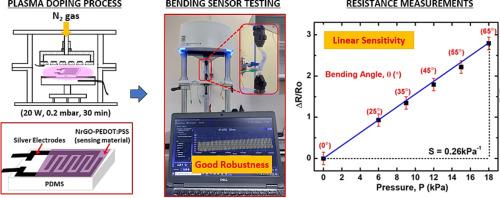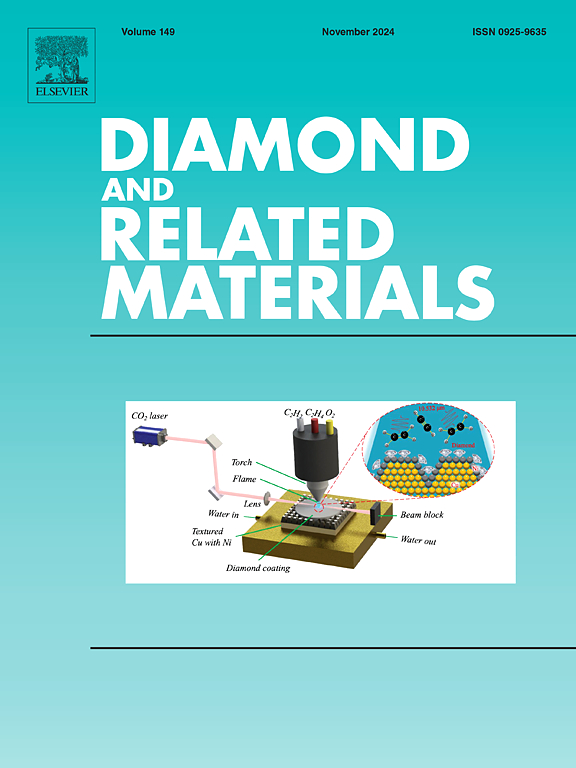氮掺杂还原氧化石墨烯-PEDOT:PSS 的弯曲响应性能:氮气流速对氮掺杂配置的影响
IF 4.3
3区 材料科学
Q2 MATERIALS SCIENCE, COATINGS & FILMS
引用次数: 0
摘要
从可穿戴设备到医疗保健监测系统,机械弯曲传感器在各种应用中发挥着举足轻重的作用。氮掺杂还原氧化石墨烯(NrGO)材料的集成已成为一种多功能方法,为提高这些传感器的性能提供了一条大有可为的途径。研究发现,材料基质中的各种氮掺杂配置会对传感器的弯曲响应产生深远影响。在这项研究中,我们发现在 10 和 20 sccm 的较低氮气流速下,吡咯烷酮-氮掺杂构型占主导地位,比例分别为 52.9% 和 48.7%。这些构型在弯曲时表现出稳定的电阻变化模式,尤其是在弯曲角度为 55° 和 65° 时。尽管在较低的弯曲角度下弯曲响应有些不一致,但传感器的灵敏度较高,达到 0.34 kPa。相比之下,以 40 sccm 的吡啶-N 构型为主要特征的传感器在不同的弯曲角度下都能保持一致的灵敏度,即使在经受 10,000 次循环后也能表现出显著的稳定性和结构稳健性。这些研究结果表明,吡啶-N 构型在提高传感器性能方面起着至关重要的作用,可确保在各种机械变形情况下进行可靠的测量。本文章由计算机程序翻译,如有差异,请以英文原文为准。

Bending response performance in nitrogen-doped reduced graphene oxide-PEDOT:PSS: The impact of nitrogen flow rate on the nitrogen doping configurations
Mechanical bending sensors play a pivotal role in various applications, from wearable devices to healthcare monitoring systems. The integration of nitrogen-doped reduced graphene oxide (NrGO) materials has emerged as a versatile approach, offering a promising avenue for enhancing the performances of these sensors. Various nitrogen doping configurations within the materials matrix have been found to profoundly influence the sensor's bending response. In this work, we identified that pyrrolic-N doping configurations were more dominant at lower nitrogen flow rates of 10 and 20 sccm, with the percentages of 52.9 and 48.7 %, respectively. These configurations exhibited a stable pattern of resistance changes in response to bending, particularly when subjected to bending angles of 55° and 65°. Despite some inconsistencies in bending response at lower bending angles, the sensors demonstrated heightened sensitivity, registering at 0.34 kPa. In contrast, sensors predominantly characterized by pyridinic-N configurations at 40 sccm maintained a consistent level of sensitivity across different bending angles, demonstrating remarkable stability and structural robustness, even after enduring 10,000 cycles. These findings indicated that pyridinic-N configurations play a critical role in enhancing sensor performance, ensuring reliable measurements across various mechanical deformations.
求助全文
通过发布文献求助,成功后即可免费获取论文全文。
去求助
来源期刊

Diamond and Related Materials
工程技术-材料科学:综合
CiteScore
6.00
自引率
14.60%
发文量
702
审稿时长
2.1 months
期刊介绍:
DRM is a leading international journal that publishes new fundamental and applied research on all forms of diamond, the integration of diamond with other advanced materials and development of technologies exploiting diamond. The synthesis, characterization and processing of single crystal diamond, polycrystalline films, nanodiamond powders and heterostructures with other advanced materials are encouraged topics for technical and review articles. In addition to diamond, the journal publishes manuscripts on the synthesis, characterization and application of other related materials including diamond-like carbons, carbon nanotubes, graphene, and boron and carbon nitrides. Articles are sought on the chemical functionalization of diamond and related materials as well as their use in electrochemistry, energy storage and conversion, chemical and biological sensing, imaging, thermal management, photonic and quantum applications, electron emission and electronic devices.
The International Conference on Diamond and Carbon Materials has evolved into the largest and most well attended forum in the field of diamond, providing a forum to showcase the latest results in the science and technology of diamond and other carbon materials such as carbon nanotubes, graphene, and diamond-like carbon. Run annually in association with Diamond and Related Materials the conference provides junior and established researchers the opportunity to exchange the latest results ranging from fundamental physical and chemical concepts to applied research focusing on the next generation carbon-based devices.
 求助内容:
求助内容: 应助结果提醒方式:
应助结果提醒方式:


